Mechanical Response Mechanism and Yield Characteristics of Coal Under Quasi-Static and Dynamic Loading
Abstract
:1. Introduction
2. Materials and Methods
2.1. Materials and Equipment
2.2. Test Methods
- (1)
- Quasi-static cyclic loading experiment
- (2)
- Dynamic loading experiment
3. Results
3.1. Comparison of Stress–Strain Curves
3.2. Comparison of Young’s Modulus Variations Under Quasi-Static and Dynamic Loading
3.3. Comparison of Cyclic Peak Stress and Strain Variations
4. Failure Characteristics and Mechanisms
4.1. Comparative Analysis of Failure Modes
4.2. Evolution of Crack Closure Stress and Damage Stress Under Dynamic Cyclic Loading–Unloading
5. Discussion
6. Conclusions
- (1)
- The stress–strain curves of coal under quasi-static loading can be divided into four stages: compaction, linear elasticity, nonlinear crack propagation, and post-peak softening. In contrast, dynamic loading induces bifurcation of the post-peak phase into first and second unloading stages due to rebound effects.
- (2)
- Under quasi-static loading, peak strain increases linearly with cycle number N, while dynamic loading exhibits nonlinear strain growth. Post-peak stress drops abruptly after quasi-static failure but declines gradually under dynamic loading due to rapid energy dissipation.
- (3)
- The AE counts during quasi-static loading transition from gradual to abrupt increases, corresponding to oblique shear failure. Under dynamic loading, lateral tensile cracks initiate first, followed by multiple axial compressive fractures.
- (4)
- The crack closure stress σcc under quasi-static loading initially decreases and then increases with N, whereas it follows an inverse trend (increase then decrease) under dynamic loading. Crack damage stress σcd generally increases with N for both regimes. However, dynamic loading produces a slight σcd reduction in the final cycle due to severe cumulative damage prior to failure.
Author Contributions
Funding
Institutional Review Board Statement
Informed Consent Statement
Data Availability Statement
Conflicts of Interest
References
- Young, M.; Walton, G.; Holley, E. Investigation of factors influencing roof stability at a Western U.S. longwall coal mine. J. Min. Sci. Technol. 2019, 29, 139–143. [Google Scholar] [CrossRef]
- Jia, Z.; Xie, H.; Zhang, R.; Li, C.; Zhang, Z. Acoustic Emission Characteristics and Damage Evolution of Coal at Different Depths Under Triaxial Compression. Rock Mech. Rock Eng. 2020, 53, 1–14. [Google Scholar] [CrossRef]
- Gong, F.; Wang, Y.; Wang, Z.; Pan, J.; Luo, S. A new criterion of coal burst proneness based on the residual elastic energy index. J. Min. Sci. Technol. 2021, 31, 553–563. [Google Scholar] [CrossRef]
- Siwek, S. Earth tides and seismic activity in deep coal mining. Int. J. Rock Mech. Min. 2021, 148, 104972. [Google Scholar] [CrossRef]
- Lyu, C.; Liu, J.; Ren, Y.; Liang, C.; Zeng, Y. Mechanical characteristics and permeability evolution of salt rock under thermal-hydro-mechanical (THM) coupling condition. Eng. Geol. 2022, 302, 106633. [Google Scholar] [CrossRef]
- Zhang, A.; Xie, H.; Zhang, R.; Gao, M.; Xie, J.; Jia, Z.; Ren, L.; Zhang, Z. Mechanical properties and energy characteristics of coal at different depths under cyclic triaxial loading and unloading. Int. J. Rock Mech. Min. 2023, 161, 105271. [Google Scholar] [CrossRef]
- Wang, X.; Wang, J.; Liu, X.; Zhou, X.; Li, N.; Feng, J.; Yang, H. Microcracking evolution and clustering fractal characteristics in coal failure under multi step and cyclic loading. Eng. Fract. Mech. 2024, 310, 110511. [Google Scholar] [CrossRef]
- Wang, Z.; Li, W.; Hu, Y. Experimental study on mechanical behavior, permeability, and damage characteristics of Jurassic sandstone under varying stress paths. Bull. Eng. Geol. Environ. 2021, 80, 4423–4439. [Google Scholar] [CrossRef]
- Lawson, H.E.; Tesarik, D.; Larson, M.K.; Abraham, H. Effects of overburden characteristics on dynamic failure in underground coal mining. Int. J. Min. Sci. Technol. 2017, 27, 121–129. [Google Scholar] [CrossRef]
- Ai, T.; Wu, S.; Zhang, R.; Gao, M.; Zhou, J.; Xie, J.; Ren, L.; Zhang, Z. Changes in the structure and mechanical properties of a typical coal induced by water immersion. Int. J. Rock Mech. Min. 2021, 138, 104597. [Google Scholar] [CrossRef]
- Gao, M.; Xie, J.; Gao, Y.; Wang, W.; Li, C.; Yang, B.; Liu, J.; Xie, H. Mechanical behavior of coal under different mining rates: A case study from laboratory experiments to field testing. Int. J. Min. Sci. Technol. 2021, 31, 825–841. [Google Scholar] [CrossRef]
- Zhang, M.; Zhang, S.; Li, C.; Zhang, D.; Wang, C.; Jin, Y. Research on the Mechanical Properties and Energy Evolution of Coal Rock under Triaxial Cyclic Gradient Loading. Solid Fuel Chem. 2025, 59, 10–20. [Google Scholar] [CrossRef]
- Tan, T.; Wang, E.; Wang, X.; Ma, L.; Yao, W. Resistivity and damage of coal under cyclic loading and unloading. Eng. Geol. 2023, 323, 107234. [Google Scholar]
- Lu, H.; Xia, C.; Xu, C.; Wang, C.; Zhao, H.; Maruvanchery, V.; Li, G. Precursory characteristics of coal-rock failure using acoustic emission and computed tomography under uniaxial monotonic and cyclic compression. Measurement 2025, 247, 116844. [Google Scholar] [CrossRef]
- Liang, Y.; Ran, Q.; Zou, Q.; Zhang, B.; Hong, Y. Experimental Study of Mechanical Behaviors and Failure Characteristics of Coal Under True Triaxial Cyclic Loading and Unloading and Stress Rotation. Nat. Resour. Res. 2022, 31, 971–991. [Google Scholar] [CrossRef]
- Liu, X.; Dai, F.; Zhang, R.; Liu, J. Static and dynamic uniaxial compression tests on coal rock considering the bedding directivity. Environ. Earth Sci. 2015, 73, 5933–5949. [Google Scholar] [CrossRef]
- Zhang, H.; Wan, Z.; Ma, D.; Zhang, Y.; Cheng, J.; Zhang, Q. Experimental Investigation on the Strength and Failure Behavior of Coal and Synthetic Materials under Plane-Strain Biaxial Compression. Energies 2017, 10, 500. [Google Scholar] [CrossRef]
- Zhou, X.; Liu, X.; Wang, X.; Liu, Y.; Xie, H.; Du, P. Acoustic Emission Characteristics of Coal Failure Under Triaxial Loading and Unloading Disturbance. Rock Mech. Rock Eng. 2022, 56, 1043–1061. [Google Scholar] [CrossRef]
- Li, X.; Zhou, Z.; Lok, T.S.; Hong, L.; Yin, T. Innovative testing technique of rock subjected to coupled static and dynamic loads. Int. J. Rock Mech. Min. Sci. 2008, 45, 739–748. [Google Scholar] [CrossRef]
- Zhao, Y.; Zhao, G.F.; Jiang, Y.; Elsworth, D.; Huang, Y. Effects of bedding on the dynamic indirect tensile strength of coal: Laboratory experiments and numerical simulation. Int. J. Coal Geol. 2014, 132, 81–93. [Google Scholar] [CrossRef]
- Feng, J.; Wang, E.; Shen, R.; Chen, L.; Li, X.; Xu, Z. Investigation on energy dissipation and its mechanism of coal under dynamic loads. Geomech. Eng. 2016, 11, 657–670. [Google Scholar] [CrossRef]
- Gu, Z.; Shen, R.; Liu, Z.; Zhao, E.; Chen, H.; Yuan, Z.; Chu, X.; Tian, J. Dynamic Characteristics of Coal under Triaxial Constraints Based on the Split-Hopkinson Pressure Bar Test System. Nat. Resour. Res. 2023, 32, 587–601. [Google Scholar] [CrossRef]
- Feng, J.; Wang, E.; Huang, Q.; Ding, H.; Zhang, X. Experimental and numerical study of failure behavior and mechanism of coal under dynamic compressive loads. J. Min. Sci. Technol. 2020, 30, 613–621. [Google Scholar] [CrossRef]
- Li, X.; Gu, H.; Tao, M.; Peng, K.; Cao, W.; Li, Q. Failure characteristics and meso-deterioration mechanism of pre-stressed coal subjected to different dynamic loads. Theor. Appl. Fract. Mec. 2021, 115, 103061. [Google Scholar] [CrossRef]
- Bagde, M.N.; Petro, V. The Effect of Machine Behaviour and Mechanical Properties of Intact Sandstone Under Static and Dynamic Uniaxial Cyclic Loading. Rock Mech. Rock Eng. 2005, 38, 59–67. [Google Scholar] [CrossRef]
- Kong, X.; Wang, E.; He, X.; Zhao, E.; Zhao, C. Mechanical characteristics and dynamic damage evolution mechanism of coal samples in compressive loading experiments. Eng. Fract. Mech. 2019, 210, 160–169. [Google Scholar] [CrossRef]
- Zhang, A.; Zhang, R.; Ai, T.; Ren, L.; Zhang, Z.; Xie, J.; Lou, C.; Xiao, K.; Yang, Z. Fatigue characteristics of deep excavation-disturbed jinping marble. J. Rock Mech. Geotech. Eng. 2025, 17, 341–356. [Google Scholar] [CrossRef]
- Ulusay, R. The ISRM Suggested Methods for Rock Characterization, Testing and Monitoring: 2007–2014; Springer International Publishing: Cham, Switzerland, 2014; Volume 15, pp. 47–48. [Google Scholar]
- Huo, L.; Gao, F.; Xing, Y.; Gao, L.; Zhou, C. A Novel Rockburst Tendency Index Based on LURR. KSCE J. Civ. Eng. 2024, 28, 5987–6000. [Google Scholar] [CrossRef]
- Xie, H.; Gao, F.; Ju, Y.; Gao, M.; Zhang, R.; Gao, Y.; Liu, J.; Xie, L. Quantitative definition and analysis of deep mining. J. China Coal Soc. 2015, 40, 1–10. [Google Scholar]
- Jin, J.F. Study on Dynamic Mechanical Characteristics of Rock Under Combined Static Load and Cycllic Impact. Ph.D. Thesis, Central South University, Changsha, China, 2012. [Google Scholar]
- Liu, X.; Cai, D.; Gu, Z.; Zhang, S.; Zhou, X.; Gao, A. Analysis of progressive damage and energy consumption characteristics of gas-bearing coal under cyclic dynamic loads. Energy 2024, 306, 132419. [Google Scholar] [CrossRef]
- Gong, F.Q.; Li, X.B.; Liu, X.L. Preliminary Experimental Study on Mechanical Characteristics of Rock Under Three-Dimensional Static and Dynamic Combined Loading. Chin. J. Rock Mech. Eng. 2011, 30, 1179–1190. [Google Scholar]
- Lu, Z.; Ju, W.; Gao, F.; Yi, K. Influence of Loading Rate on the Failure Characteristics of Composite Coal–Rock Specimens Under Quasi-static Loading Conditions. Rock Mech. Rock Eng. 2022, 55, 909–921. [Google Scholar] [CrossRef]
- Zhu, J.; Zhang, B.; Zhang, J.J.Y. Coal pore characteristics in different coal mine dynamic disasters. Arab. J. Geosci. 2018, 11, 499. [Google Scholar] [CrossRef]
- Altman, D.G.; Machin, D.; Bryant, T.N.; Gardner, M.J. Statistics with confidence: Confidence intervals and statistical guidelines. Wiley: London, UK, 2000. [Google Scholar]
- Liang, Y.; Yang, Y.; Xin, G.; Zou, Q.; Ran, Q.; Qin, D. Mechanical properties and crack propagation characteristics of mudstone under different loading frequencies. Eng. Fract. Mech. 2025, 316, 110863. [Google Scholar] [CrossRef]
- Zhao, G.M.; Ma, W.W.; Meng, X.R. Failure Modes and Energy Characteristics of Rock-like Materials Under Dynamic Loading. Rock Soil Mech. 2015, 36. [Google Scholar]
- Mandelbrot, B.B. The Fractal Geometry of Nature; Freeman House Publishing: San Francisco, CA, USA, 1982. [Google Scholar]
- Zhou, Z.; Wang, P.; Cai, X.; Zhao, Y.; Liu, J.; Yan, Z.; Chen, L. Estimating crack closure and damage stress thresholds of rock during uniaxial compression based on axial plastic strain. J. Cent. South Univ. 2023, 30, 3335–3348. [Google Scholar] [CrossRef]
- Duan, Y.; Zhang, G.; Qin, T. Analysis of Crack-Characteristic Stress and Energy Characteristics of Sandstone under Triaxial Unloading Confining Pressure. Appl. Sci. 2023, 13, 2671. [Google Scholar] [CrossRef]
- Zhang, M.; Zhang, G.; Sun, W.; Chen, L.; Zheng, X.; Xu, C. Effect of crack density on crack initiation and damage for high confining pressure using wave velocities. Geomech. Geophys. Geo-Energy Geo-Resour. 2024, 10, 92. [Google Scholar] [CrossRef]
- Ghasemi, S.; Khamehchiyan, M.; Taheri, A.; Nikudel, M.R.; Zalooli, A. Microcracking Behavior of Gabbro During Monotonic and Cyclic Loading. Rock Mech. Rock Eng. 2021, 54, 2441–2463. [Google Scholar] [CrossRef]
- Zhang, Z.Z.; Gao, F. Study on Confining Pressure Effect of Energy Evolution of Loaded Rock. Chin. J. Rock Mech. Eng. 2015, 34, 1–11. [Google Scholar]
- Ray, S.K.; Sarkar, M.; Singh, T.N. Effect of cyclic loading and strain rate on the mechanical behaviour of sandstone. Int. J. Rock Mech. Min. 1999, 36, 543–549. [Google Scholar] [CrossRef]
- Cao, R.; Wang, H.; Qiu, X.; Wang, C.; Lin, H.; Qiao, Q. Damage characteristics and fracture behaviour of marble after cycle impact loading. Theor. Appl. Fract. Mec. 2023, 125, 103903. [Google Scholar] [CrossRef]
- Sun, B.; Yang, P.; Liu, S.; Zeng, S. Impact dynamic characteristics and constitutive model of granite damaged by cyclic loading. J. Mater. Res. Technol. 2023, 24, 333–345. [Google Scholar] [CrossRef]


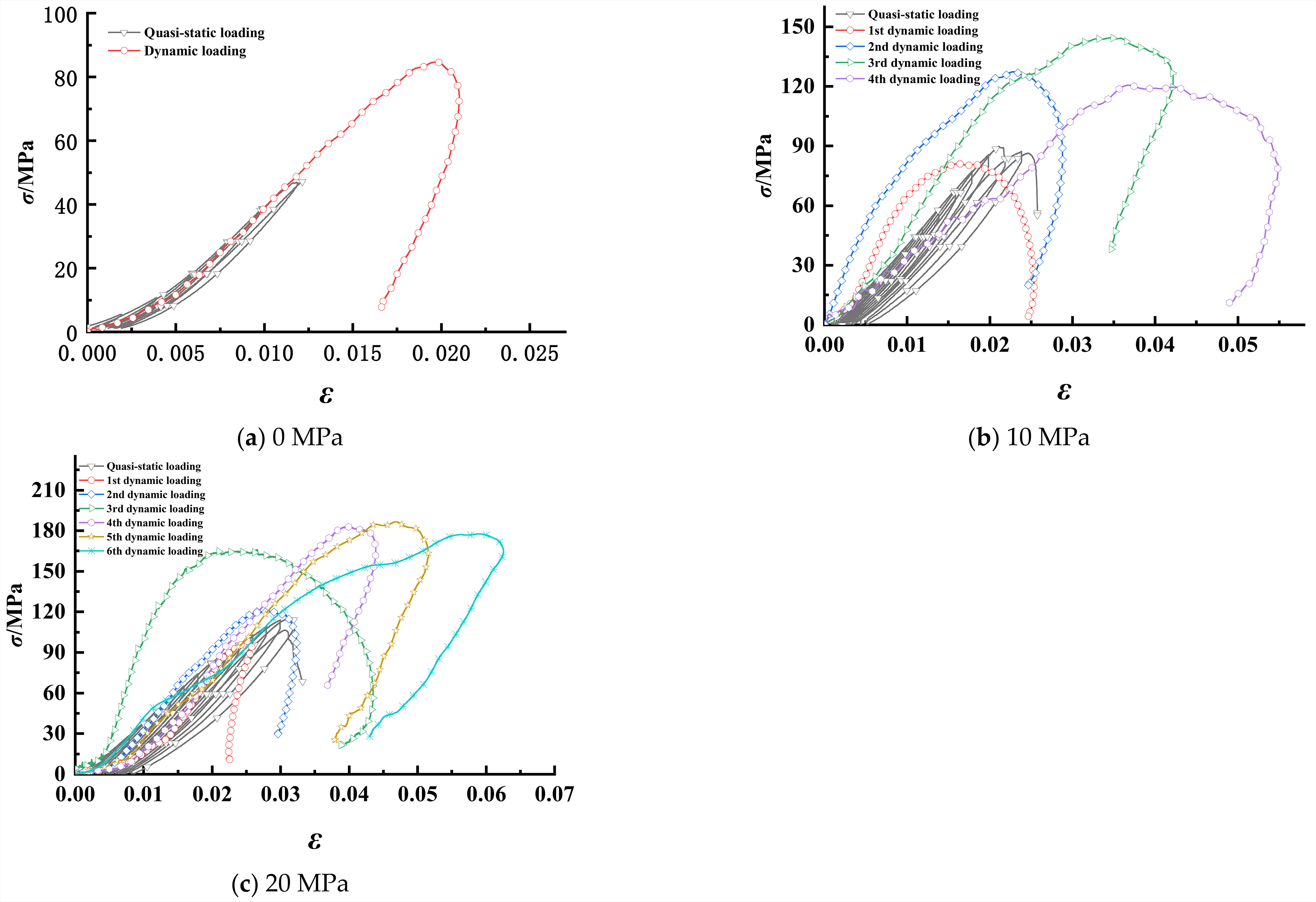
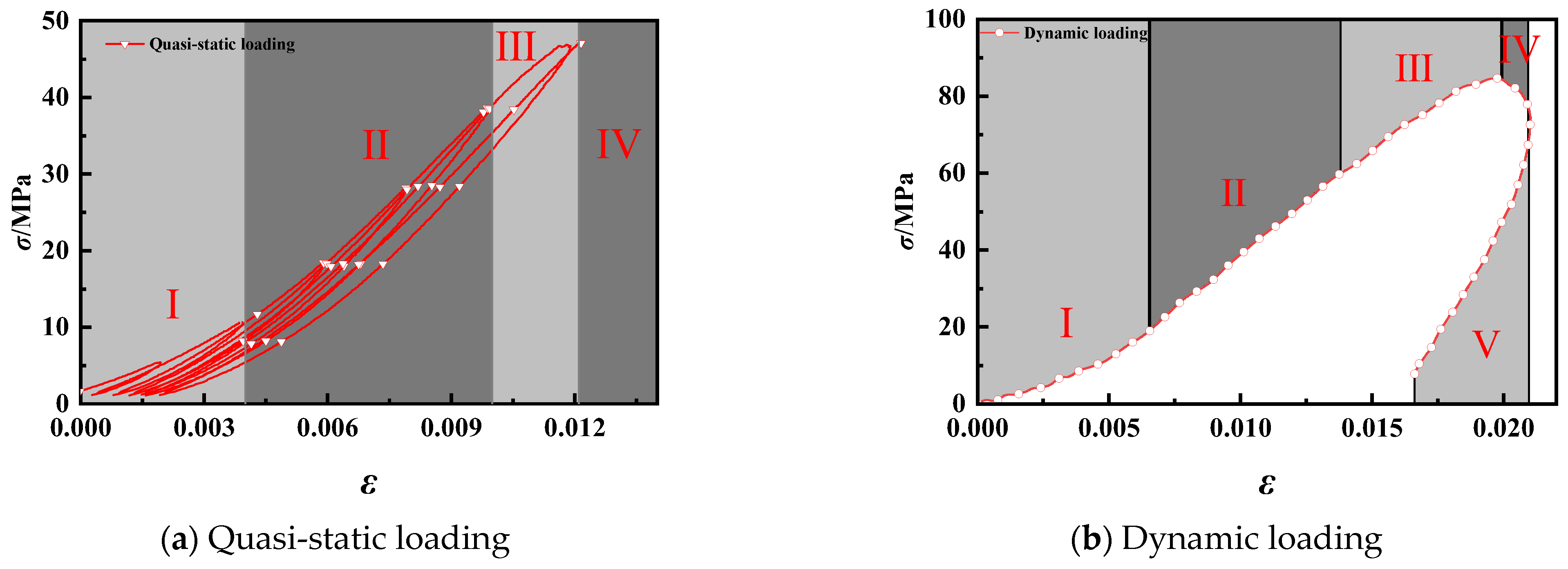
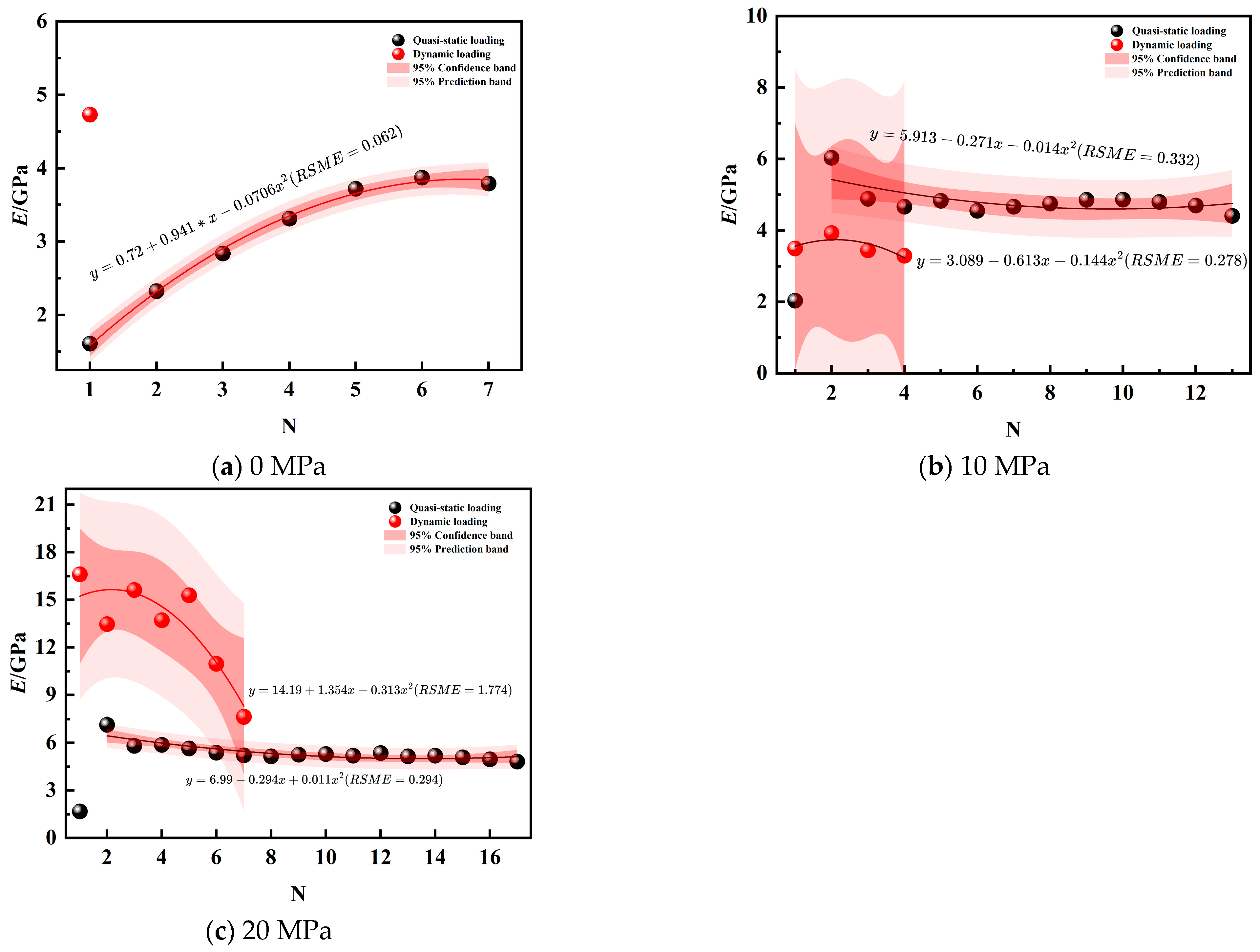
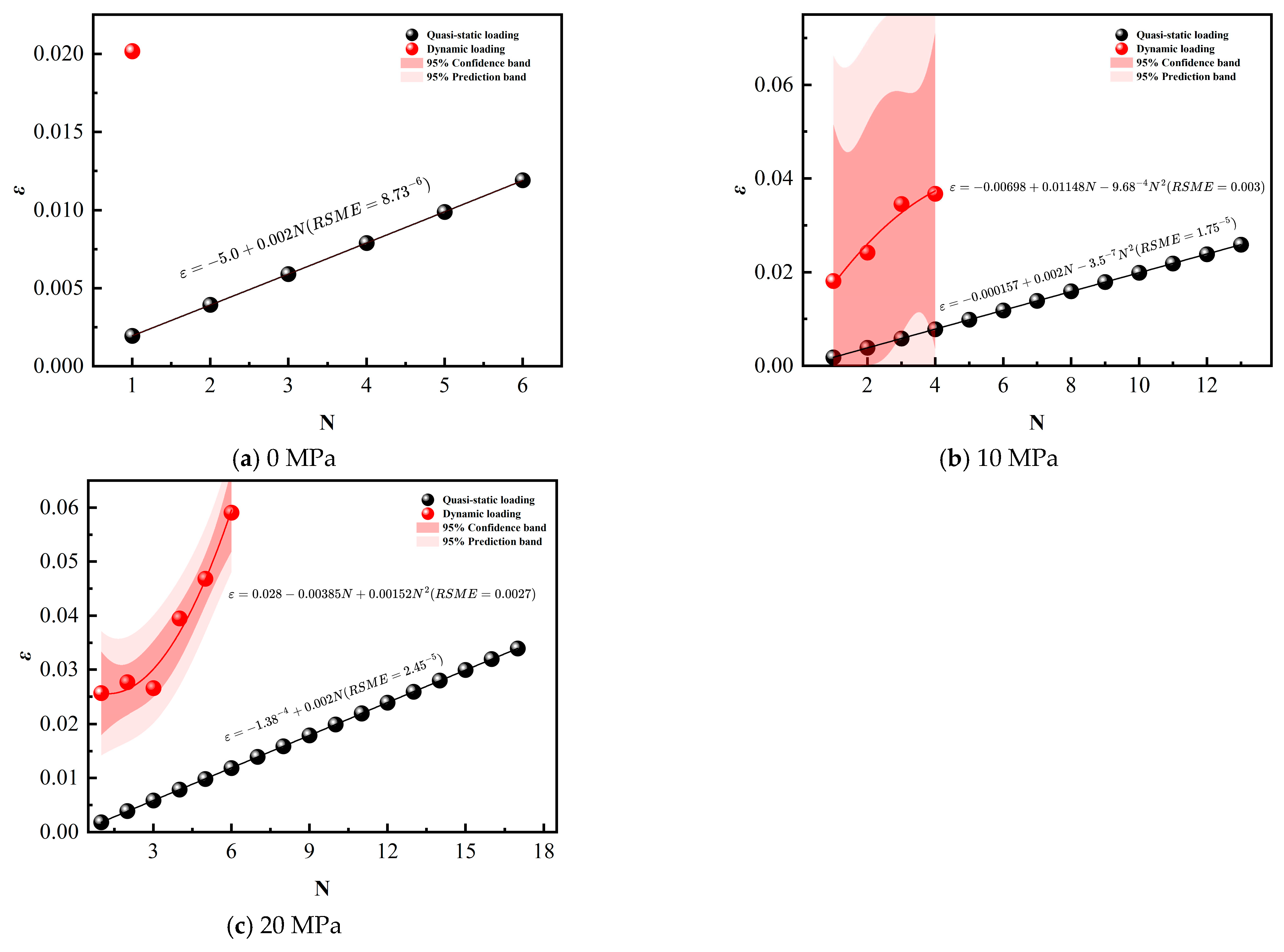

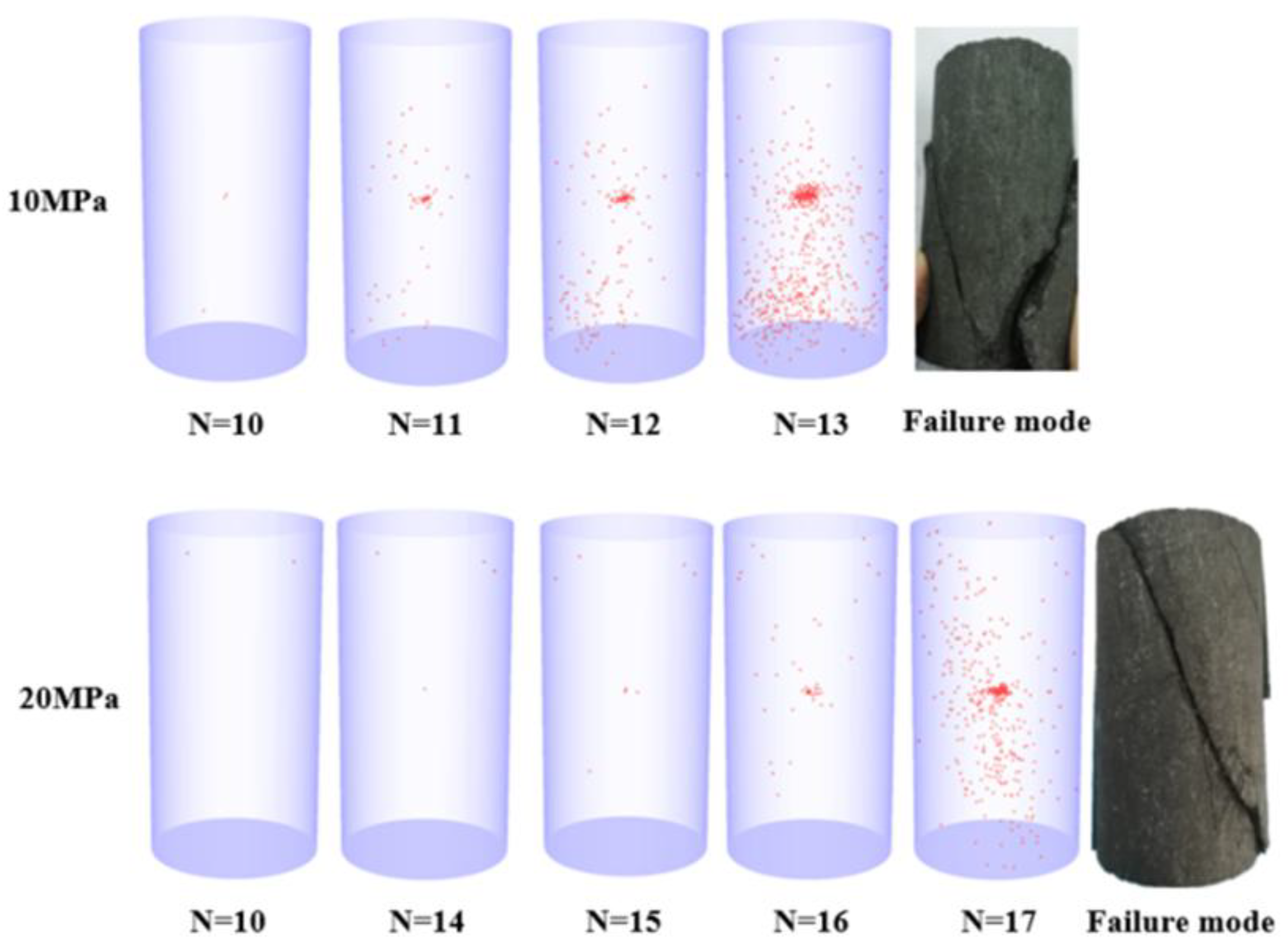
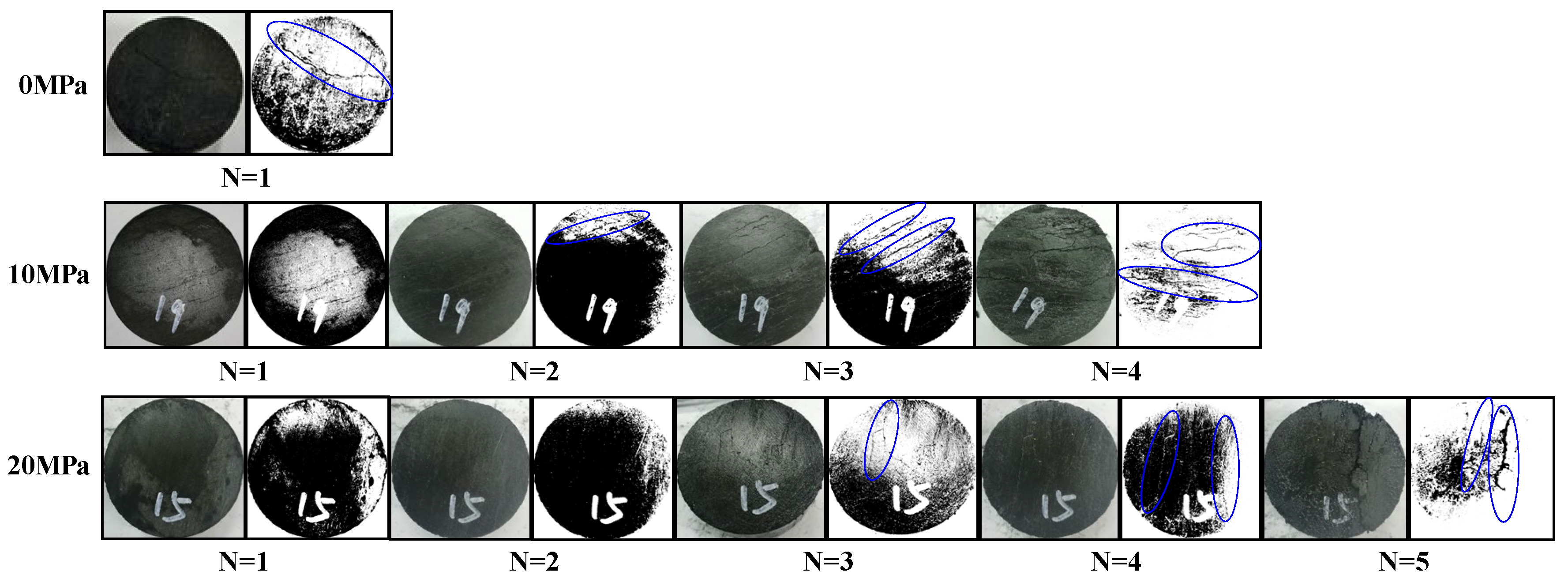
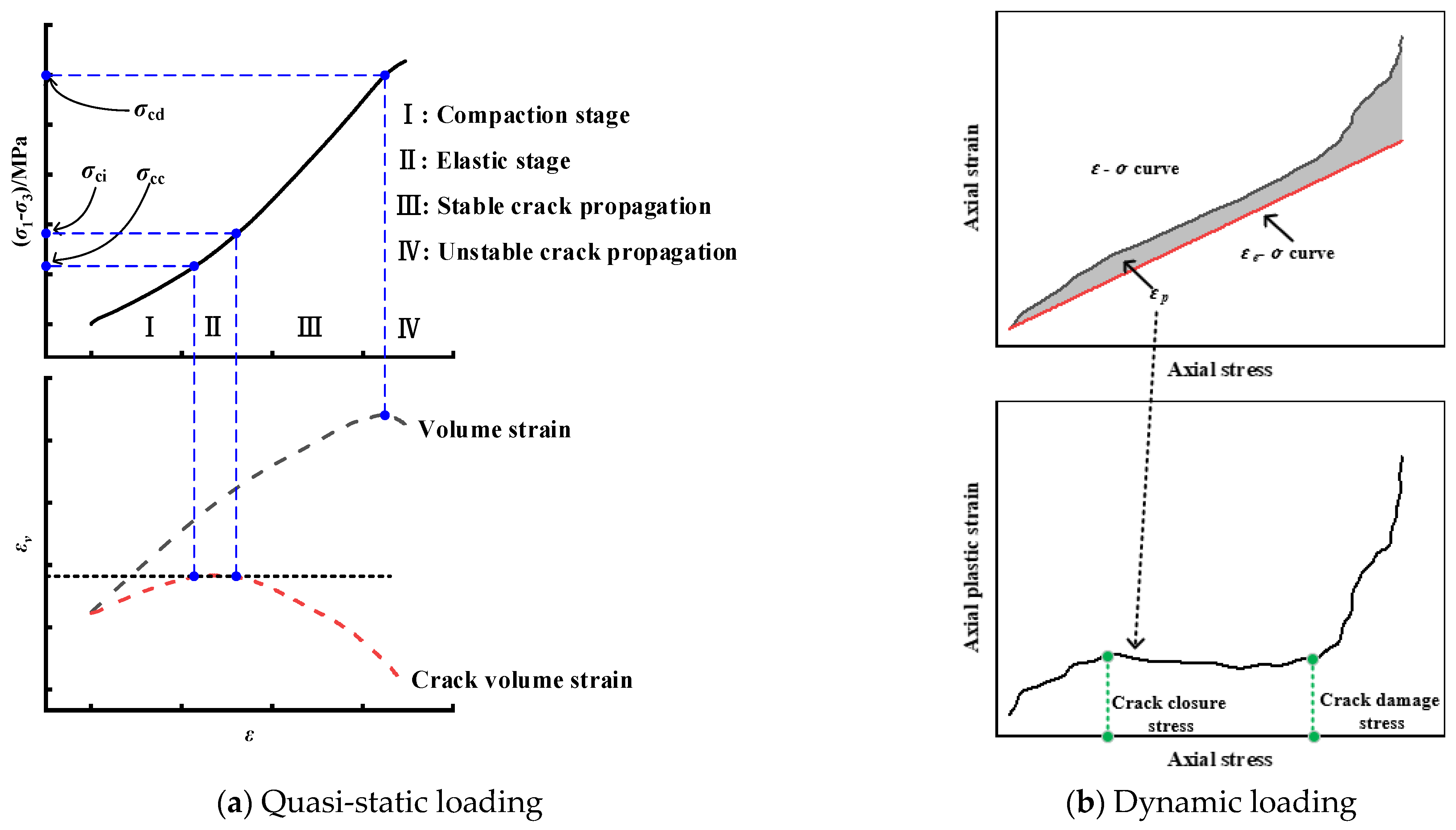
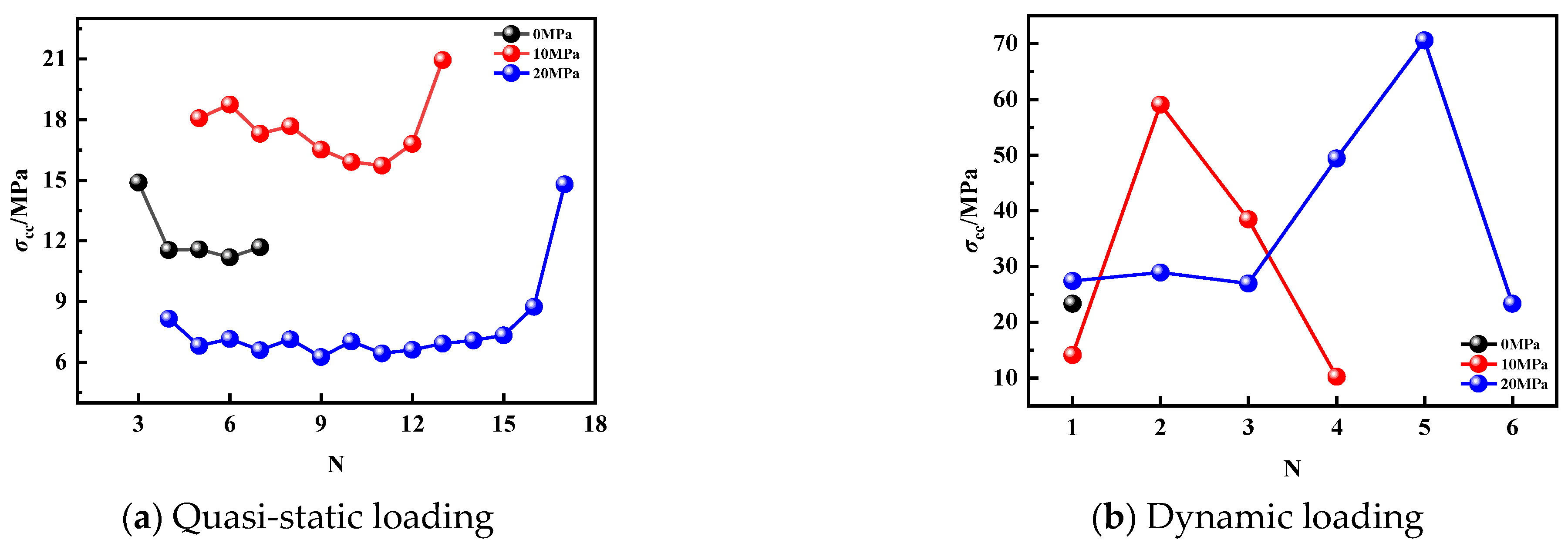
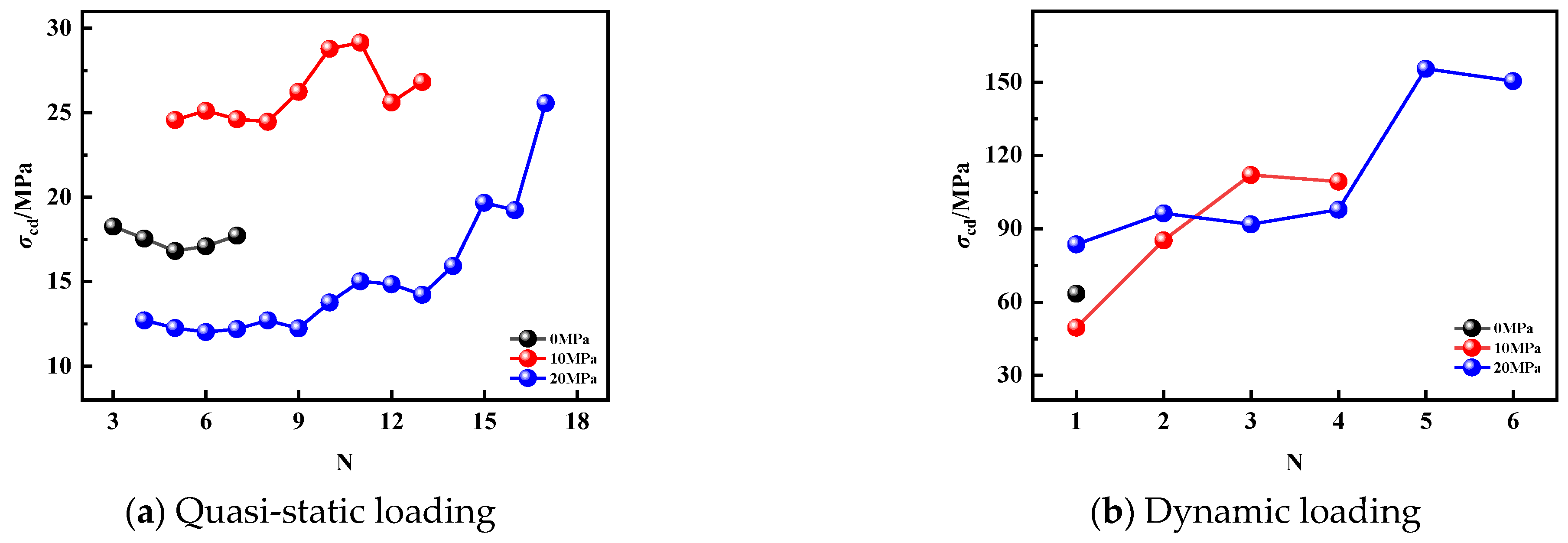

| No. | Confining Pressure /MPa | Height /mm | Diameter/ mm | Mass /g | Wave Velocity /km/s | No. | Confining Pressure /MPa | Height /mm | Diameter/ mm | Mass /g | Wave Velocity /km/s |
|---|---|---|---|---|---|---|---|---|---|---|---|
| 1 | 0 | 25.15 | 49.99 | 82.25 | 2.275 | 1 | 0 | 99.94 | 49.95 | 324.56 | 2.655 |
| 2 | 0 | 25.54 | 49.97 | 76.44 | 2.096 | 2 | 0 | 100.30 | 50.00 | 324.96 | 2.704 |
| 3 | 10 | 25.35 | 49.97 | 81.79 | 2.389 | 3 | 10 | 100.25 | 49.99 | 328.42 | 2.666 |
| 4 | 10 | 25.35 | 50.00 | 69.18 | 2.006 | 4 | 10 | 100.51 | 49.95 | 336.98 | 2.547 |
| 5 | 20 | 24.90 | 49.94 | 81.93 | 2.248 | 5 | 20 | 100.07 | 49.97 | 328.12 | 2.655 |
| 6 | 20 | 25.01 | 49.96 | 82.04 | 2.389 | 6 | 20 | 100.13 | 49.99 | 344.16 | 2.732 |
| Tolerance | 0.64 | 0.06 | 13.07 | 1.14 | Tolerance | 0.57 | 0.05 | 19.6 | 0.185 | ||
Disclaimer/Publisher’s Note: The statements, opinions and data contained in all publications are solely those of the individual author(s) and contributor(s) and not of MDPI and/or the editor(s). MDPI and/or the editor(s) disclaim responsibility for any injury to people or property resulting from any ideas, methods, instructions or products referred to in the content. |
© 2025 by the authors. Licensee MDPI, Basel, Switzerland. This article is an open access article distributed under the terms and conditions of the Creative Commons Attribution (CC BY) license (https://creativecommons.org/licenses/by/4.0/).
Share and Cite
Huo, L.; Gao, F.; Xing, Y. Mechanical Response Mechanism and Yield Characteristics of Coal Under Quasi-Static and Dynamic Loading. Appl. Sci. 2025, 15, 5238. https://doi.org/10.3390/app15105238
Huo L, Gao F, Xing Y. Mechanical Response Mechanism and Yield Characteristics of Coal Under Quasi-Static and Dynamic Loading. Applied Sciences. 2025; 15(10):5238. https://doi.org/10.3390/app15105238
Chicago/Turabian StyleHuo, Liupeng, Feng Gao, and Yan Xing. 2025. "Mechanical Response Mechanism and Yield Characteristics of Coal Under Quasi-Static and Dynamic Loading" Applied Sciences 15, no. 10: 5238. https://doi.org/10.3390/app15105238
APA StyleHuo, L., Gao, F., & Xing, Y. (2025). Mechanical Response Mechanism and Yield Characteristics of Coal Under Quasi-Static and Dynamic Loading. Applied Sciences, 15(10), 5238. https://doi.org/10.3390/app15105238






